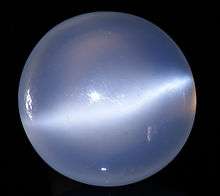Adularescence
Adularescence is an optical phenomenon, similar to labradorescence and aventurescence, that is produced in gemstones such as moonstones.

Description
The effect of adularescence, also commonly referred to as schiller or shiller, is best described as a milky, bluish luster or glow originating from below the surface of the gemstone. The schiller, appearing to move as the stone is turned (or as the light source is moved), gives the impression of lunar light floating on water (accounting for moonstone's name).[1] Though white schiller is the most common, in rarer specimens, orange or blue lusters are produced.[2]
This effect is most typically produced by adularia, from which the name derives.[3][4][5] Adularescence appears in numerous other gemstones, notably common opal, rose quartz and agate. However, due to inclusions in these other stones, the effect is displayed differently. The schiller is scattered by inclusions and appears hazy; non-hazy specimens are specially referred to as "milky". Thus, adularescence occurring in non-adularia gemstones is termed differently – the "girasol effect" and opalescence (for opals only) are two such terms. When the schiller forms an indistinct band, it is said to display a chatoyant effect. Only clearly defined bands are referred to as "cat's eyes".[5]
As an optical phenomenon, adularescence exists only in the presence of light; it is a product of the interaction between light and the internal microstructures of the mineral and not a property of the mineral itself. The effect is produced by alternating layers of two types at a scale near the wavelength of light (approximately 0.5 micron) – this leads to light scattering and interference.[6]
References
- Long, Bill (2004), "Varieties of Light II: Pleochroism, Nacreous, Adularescence, A(d)venturescence."
- Semi Precious Stones Guide: List of Gemstone Phenomena
- King, R. J. (1990). "Minerals explained 12: Alkali feldspar (Part 2)." Geology Today, 6 pp. 27-29.
- "Adularescence," reference.com
- Shipley, Robert M. (2007), Dictionary of Gems and Gemology, Read Books, p. 93.
- Nassau, Kurt (1978). "The origins of color in minerals," American Mineralologist, vol. 63, pp. 219-229.